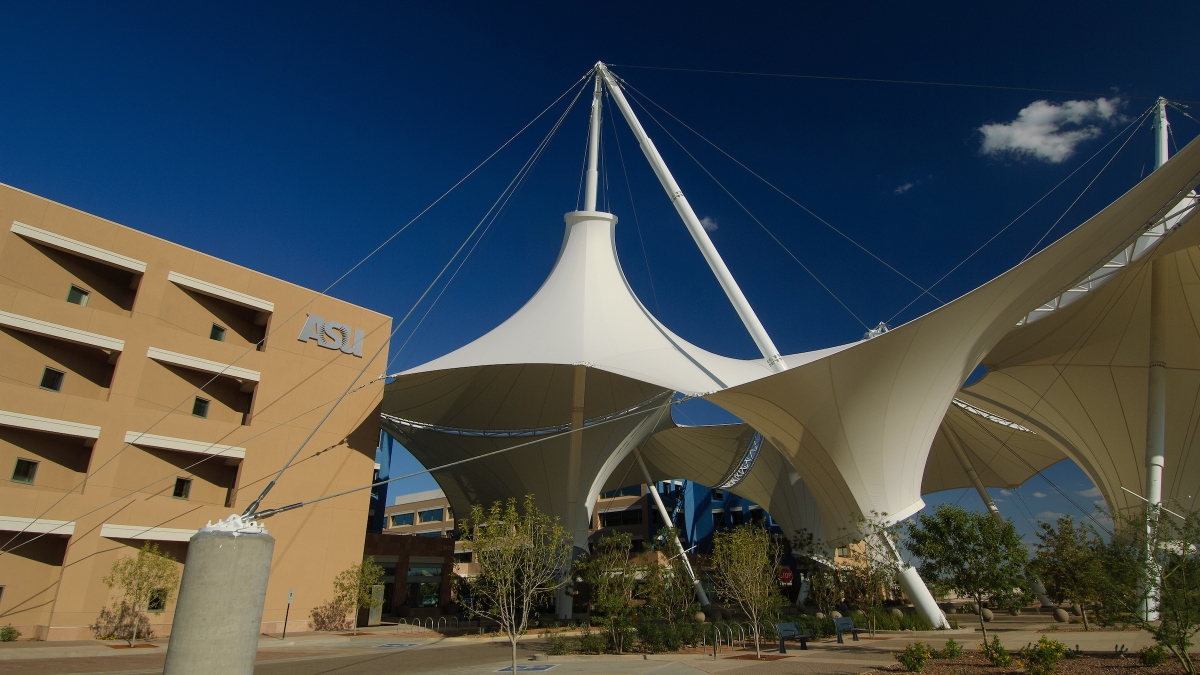Editor's note: This story is being highlighted in ASU Now's year in review. Read more top stories from 2018 here.
Arizona State University now ranks No. 17 of all universities worldwide for U.S. patents awarded, according to a new report by the U.S. National Academy of Inventors and the Intellectual Property Owners Association. Other universities ranked alongside ASU in the top 20 include MIT, Stanford University, Johns Hopkins University, Harvard and the California Institute of Technology.
ASU earned 100 patents in 2017, up from 62 in 2016, and jumped 13 spots from last year, ranking ahead of Columbia University, the University of Washington and Duke University.
“The rate at which ASU is producing high-quality innovations is a testament to both the caliber of the university’s knowledge enterprise and the success of our technology transfer model, which fast-tracks research from lab benches to commercial application,” said Augie Cheng, CEO of Skysong Innovations, which manages ASU’s technology portfolio. “ASU is truly a world-class research institution.”
The National Academy of Inventors and Intellectual Property Owners Association have published the Top 100 Worldwide Universities Granted U.S. Utility Patents report annually since 2013. The report utilizes data acquired from the U.S. Patent and Trademark Office to highlight the important role patents play in university research and innovation. The rankings are compiled by calculating the number of utility patents granted by the U.S. Patent and Trademark Office that list a university as the first assignee on the issued patent.
“At ASU, our support of inventors is driven by the desire to empower people who are working tirelessly to advance new ideas to have a significant impact on communities around the world,” said Sethuraman Panchanathan, executive vice president of Knowledge Enterprise Development and chief research and innovation officer at ASU. “Our rise in these rankings is reflective of the innovative spirit that permeates ASU fueled by the outstanding ideas advanced by our faculty, researchers and students who are committed to use-inspired research and societal impact.”
Among the 100 patents awarded to ASU are technologies for diagnosing and treating autism, for detecting explosive materials and for monitoring the environment and human health.
New hope for autism diagnosis and treatment
A team led by ASU researchers is taking a novel approach to the search for effective autism treatments by focusing on improving the gut microbiome. The patent aims to provide a better understanding of the association between gut microbes, health and disease states, and provides for potential diagnostic and therapeutic targets. Of high interest are diseases like autism spectrum disorder (ASD), which is a complex neurobiological disorder whose chief manifestations are qualitative impairment in social interaction and communication and restricted repetitive and stereotyped patterns of behavior, interests and activities. There remains a need for understanding the role of the microbiome in the healthy gut vs. the unhealthy gut for those suffering from ASD.
This patent is for a method that measures the autism-associated changes in intestinal microbial diversity as well as various potential treatments of autism spectrum disorder-gut related symptoms/complications. The ASU research group is led by James Adams, Rosa Krajmalnik-Brown and Dae-Wook Kang.
Detecting improvised explosives
Researchers at ASU have developed a technology for improved detection of improvised peroxide explosives, which can be made from common, inexpensive chemicals that are readily available all over the world. Current sensors are easily damaged and become useless when they come in contact with moisture and saline vapor, as is found in the atmosphere along coastal areas and ports.
ASU’s patented technology is a very thin coating that provides a barrier to moisture and saline vapors, without degrading the sensor’s detection ability. Furthermore, the innovation improves the manufacturing process of the sensors, allowing for smaller detectors to be manufactured more quickly. Potential applications include military force protection, aviation threat detection and live event security. The work is led by Indu Mishra and William Petuskey.
Miniature sensors sniff out environmental contaminants
This ASU invention has made a series of new chemical sensors to sniff out environmental pollutants and, potentially, treat people with asthma as well.
Nitrogen oxides are important environmental pollutants. Their levels in human breath are also key biomarkers of diseases, such as asthma. Existing methods and devices may detect unknown analytes but are generally slow, expensive or bulky. The ASU team, led by N.J. Tao, has developed a new, miniaturized sensor that may have applications not only in environmental monitoring, but also as noninvasive medical diagnosis and management devices for asthma and other diseases. The sensors have been configured or used for lab-based analytical devices, or mobile handheld or portable chemical sensors and tasks to monitor in the field or clinic.
Joseph Caspermeyer and Derek Sarley contributed to this story. Top image by Andy DeLisle/ASU
More Science and technology

Applied Materials invests in ASU to advance technology for a brighter future
For nearly 60 years, global giant Applied Materials has been hard at work engineering technology that continues to change how microchips are made.Their products power everything from flat-panel…

Meet ASU engineering students who are improving health care, computing and more
Furthering knowledge of water resource management, increasing the efficiency of manufacturing point-of-care health diagnostic tools and exploring new uses for emerging computer memory are just some…

Turning up the light: Plants, semiconductors and fuel production
What can plants and semiconductors teach us about fuel production?ASU's Gary Moore hopes to find out.With the aim of learning how to create viable alternatives to fossil-based fuels, Moore — an…


